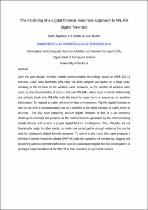JavaScript is disabled for your browser. Some features of this site may not work without it.
- ResearchSpace
- →
- Research Publications/Outputs
- →
- Conference Publications
- →
- View Item
| dc.contributor.author |
Ngobeni, Sipho J

|
|
| dc.contributor.author |
Venter, HS

|
|
| dc.contributor.author |
Burke, Ivan D

|
|
| dc.date.accessioned | 2013-11-13T11:45:40Z | |
| dc.date.available | 2013-11-13T11:45:40Z | |
| dc.date.issued | 2010-01 | |
| dc.identifier.citation | Ngobeni, S, Venter, HS and Burke, I. 2010. The modeling of a digital forensic readiness approach to WLAN digital forensics. In: 6th Annual IFIP WG 11.9 International Conference on Digital Forensics, University of Hong Kong, Hong Kong, 3-6 January 2010 | en_US |
| dc.identifier.uri | http://hdl.handle.net/10204/7064 | |
| dc.description | 6th Annual IFIP WG 11.9 International Conference on Digital Forensics, University of Hong Kong, Hong Kong, 3-6 January 2010 | en_US |
| dc.description.abstract | Over the past decade, wireless mobile communication technology based on IEEE 802.11 Wireless Local Area Networks (WLANs) has been adopted worldwide on a large scale, resulting in the increase of the wireless users. However, as the number of wireless users soars, so does the possibility of cyber crime over WLANs, where cyber criminals deliberately and actively break into WLANs with the intent to cause harm or eavesdrop on sensitive information. To respond to cyber crime in wireless environments, WLAN digital forensics is seen as not only a counterproposal but as a solution to the rapid increase of cyber crime in WLANs. The key issue impacting WLAN digital forensics is that, it is an enormous challenge to intercept and preserve all the communications generated by the communicating mobile devices and conduct a proper digital forensic investigation. Thus, WLANs are not forensically ready. In other words, currently one cannot gather enough evidence that can be used for subsequent digital forensic purposes. To attend to this issue, this paper proposes a Wireless Forensic Readiness Model (WFRM) with the capability of monitoring, logging and preserving wireless network traffic to be used in a subsequent digital forensic investigation. A prototype implementation of the WFRM is then presented as a proof of concept. | en_US |
| dc.language.iso | en | en_US |
| dc.relation.ispartofseries | Workflow request;3529 | |
| dc.subject | Wireless LAN | en_US |
| dc.subject | Digital forensics readiness | en_US |
| dc.subject | Digital forensic process | en_US |
| dc.subject | Access points | en_US |
| dc.title | The modeling of a digital forensic readiness approach to WLAN digital forensics | en_US |
| dc.type | Conference Presentation | en_US |
| dc.identifier.apacitation | Ngobeni, S., Venter, H., & Burke, I. D. (2010). The modeling of a digital forensic readiness approach to WLAN digital forensics. http://hdl.handle.net/10204/7064 | en_ZA |
| dc.identifier.chicagocitation | Ngobeni, S, HS Venter, and Ivan D Burke. "The modeling of a digital forensic readiness approach to WLAN digital forensics." (2010): http://hdl.handle.net/10204/7064 | en_ZA |
| dc.identifier.vancouvercitation | Ngobeni S, Venter H, Burke ID, The modeling of a digital forensic readiness approach to WLAN digital forensics; 2010. http://hdl.handle.net/10204/7064 . | en_ZA |
| dc.identifier.ris | TY - Conference Presentation AU - Ngobeni, S AU - Venter, HS AU - Burke, Ivan D AB - Over the past decade, wireless mobile communication technology based on IEEE 802.11 Wireless Local Area Networks (WLANs) has been adopted worldwide on a large scale, resulting in the increase of the wireless users. However, as the number of wireless users soars, so does the possibility of cyber crime over WLANs, where cyber criminals deliberately and actively break into WLANs with the intent to cause harm or eavesdrop on sensitive information. To respond to cyber crime in wireless environments, WLAN digital forensics is seen as not only a counterproposal but as a solution to the rapid increase of cyber crime in WLANs. The key issue impacting WLAN digital forensics is that, it is an enormous challenge to intercept and preserve all the communications generated by the communicating mobile devices and conduct a proper digital forensic investigation. Thus, WLANs are not forensically ready. In other words, currently one cannot gather enough evidence that can be used for subsequent digital forensic purposes. To attend to this issue, this paper proposes a Wireless Forensic Readiness Model (WFRM) with the capability of monitoring, logging and preserving wireless network traffic to be used in a subsequent digital forensic investigation. A prototype implementation of the WFRM is then presented as a proof of concept. DA - 2010-01 DB - ResearchSpace DP - CSIR KW - Wireless LAN KW - Digital forensics readiness KW - Digital forensic process KW - Access points LK - https://researchspace.csir.co.za PY - 2010 T1 - The modeling of a digital forensic readiness approach to WLAN digital forensics TI - The modeling of a digital forensic readiness approach to WLAN digital forensics UR - http://hdl.handle.net/10204/7064 ER - | en_ZA |






